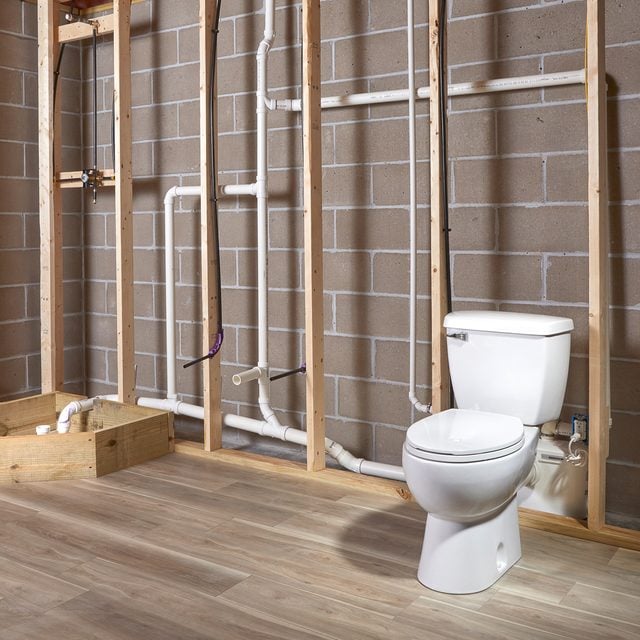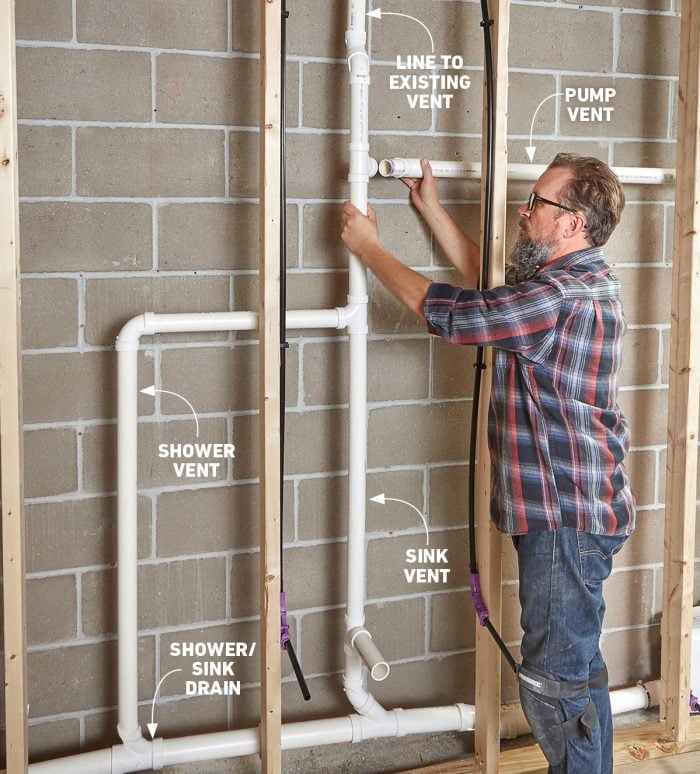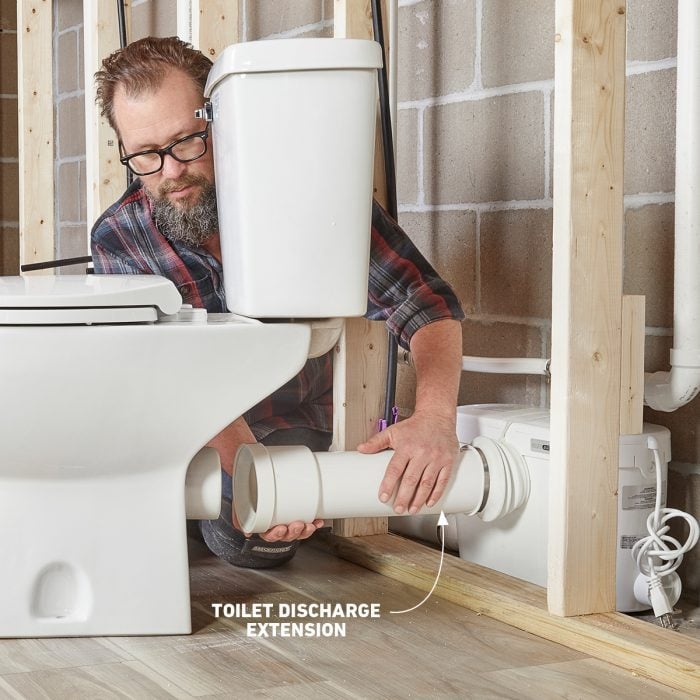How To Add A Bathroom To A Basement
How to Add together a Bathroom to a Basement the Piece of cake Way
Add a bathroom in your basement without busting upwards the concrete floor.
![]() Time
Time
Multiple Days
![]() Complexity
Complexity
Intermediate
![]() Cost
Cost
$1200-1300
Introduction
Need another total bathroom in your dwelling house? Here'southward a style to install one in your basement with a dissimilar kind of toilet and plumbing.
Tools Required
Materials Required
- Framing lumber
- GFCI outlet
- PVC adhesive
- PVC pipe
- Saniflo SaniAccess 3
The improver of a full bathroom with a shower, sink and toilet tin be a huge improvement to any home, particularly if you accept only one bath and a growing family. It tin can also be a huge, expensive job.
Upflow bathroom systems simplify the plumbing of a basement bathroom, putting this valuable home improvement job within reach of a DIYer.These systems include a macerator/pump that can be tucked into a wall straight backside a rear-belch toilet.
All the fixture drains flow to the macerator/pump, which grinds solids so pumps waste material upward to connect to your master drain line, instead of relying on gravity. Shower and sink drains practise use gravity to reach the pump, and those are like shooting fish in a barrel installations.

What is a Macerating Toilet?
Recollect of it every bit similar to a garbage disposal in your sink. In a macerating toilet, waste product is channeled to the macerator/pump, which reduces solids to be easily pumped through a 3/4-in. discharge pipe.
Our system, the SaniAccess 3 from Saniflo, includes a rear-discharge toilet and a macerator/pump with fittings. You'll supply the rest of the standard plumbing pipes and fittings.
System Advantages
The biggest advantage of an upflow arrangement is not breaking upwards a concrete flooring to run drains. There are other advantages, besides.
Offset, the discharge line is much smaller than a standard drain line, so you tin fit it into places where a standard drain might not work. 2nd, you lot can install a bathroom anywhere. You don't need to be concerned with how the toilet drain aligns with existing drain lines in your home.
Meet the Adept
Carmen Bossi, the president/founder of Saniflostore.com
Project step-past-step (ten)
Footstep 1
Place the Macerator/Pump
Set the macerator/pump in place behind the wall framing. The unit of measurement needs to be on the same level as the toilet. Install the rubber feet and secure the pump to the floor.
If you're in a cold climate, allow space between the pump and the wall for insulation. Insulation in front end of the pump will help dampen the minimal racket from the macerator/pump.

Step 2
Install a GFCI Outlet
The macerator/pump needs its own GFCI outlet. Install the outlet inside the wall framing, nearly the pump. The outlet needs to be inside 12 inches of an access panel and facing the room. Be sure to check local codes before installing this outlet.

Footstep iii
Build the Shower Pan Footstep-Up
With your shower plumbing in paw, summate the pinnacle of the platform, including the P-trap as well as a 1/4-in. driblet per pes of horizontal run to the pump. The minimum tiptop is six inches, and that's ordinarily plenty depending on your P-trap and the distance to the pump. You may need to add an actress step, depending on the finished height.
To lower the platform height, chip out some concrete for the P-trap. If your basement has low ceilings, you may need to consider a tub instead of a shower.

Step iv
Connect the Shower and Sink Drains
Hook up the shower drain and run the piping into the wall. Use an elbow to turn the piping toward the pump. In our bathroom, the sink is between the shower and the toilet, then nosotros tied in the sink drain on the way to the pump.
The pump has a drain entrance on both sides, so yous tin can configure your bathroom all the same you like. In our case, we used a provided plug to cap the entrance on the other side of the pump.

Footstep v
Install the Vents
Forth the bleed line, you lot'll install a vent for each fixture. Connect these vents and necktie them into the vent system on your existing plumbing. Mechanical vents won't piece of work with this organization; merely a free air vent can be used.

Footstep 6
Connect the Belch to the Pump
Skid the flexible discharge tube onto its port on the pump and secure it with a hose clamp. At the end of the tube, yous tin can install a shutoff ball valve. If you always need to remove the pump, that valve will forbid backflow.
After the first hard 90-degree turn from the pump, any turns in the discharge pipe demand to be sweeping — no more difficult 90s. Employ a sweep elbow or two 45-caste elbows instead.

Step 7
Connect the Discharge to the Primary Sewer Line
The belch line can run horizontally at starting time, but for no more than xviii inches earlier it turns vertically. After the commencement vertical turn, the pipe can run horizontally over again just non make another vertical or diagonal turn. The total run from the pump to the main sewage line must be a minimum of three feet.
The easiest place to tie into the main drain is at a cleanout using a reducer fitting. If that's not an option, you can install a Y-fitting (non a T-fitting) on any horizontal run, but the discharge must enter the pipe from the top or side. No other lines tin feed into the belch from the pump.

Pace 8
Discharge Options
If y'all have a cleanout in a convenient spot, you can connect the discharge there. Simply remove the plug and install a reducer to connect the iii/four-in. discharge pipe.
If your drains are steel pipe, you'll need to cutting out a section and install a Y-plumbing equipment using mission clamps. You can't apply the blazon that just accept hose clamps, though — only the fully banded blazon.

Pace 9
Connect the Toilet
Set the toilet into position, then connect the flexible boot to the toilet's belch port. Next, connect the boot on the other end to the pump. Make sure the connection kick faces the right direction. Goose egg ties keep the kick in place, equally this is a drain, not a pressurized supply line.
- Pro tip: Making a direct cut on a large-diameter piping starts with an authentic line. Wrap a slice of cardboard with one straight border around the pipe and mark your line with a Sharpie.
- Pro tip: To brand the cut, offset saw all the style effectually the pipe just enough to remove the marking. Keep sawing a little deeper each time effectually until you're through the pipage.

Step 10
Install the Toilet
Marker holes on the flooring through the holes on the toilet base of operations. Slide the toilet out of the way, then drill the holes for the supplied concrete anchors using a correct size masonry bit. Slide the toilet back into position, and and then install the lag screw anchors.
Use shims under the toilet as needed to keep it from rocking. Exist careful non to overtighten the bolts; you can crack the toilet.

Originally Published: November 09, 2021
How To Add A Bathroom To A Basement,
Source: https://www.familyhandyman.com/project/add-basement-bathroom/
Posted by: puckettsectirepas.blogspot.com



0 Response to "How To Add A Bathroom To A Basement"
Post a Comment